Selsey
Selsey is a seaside town and civil parish, about eight miles (12 km) south of Chichester in West Sussex, England. Selsey lies at the southernmost point of the Manhood Peninsula, almost cut off from mainland Sussex by the sea. It is bounded to the west by Bracklesham Bay, to the north by Broad Rife (rife[3] being the local word for stream or creek), to the east by Pagham Harbour and terminates in the south at Selsey Bill. There are significant rock formations beneath the sea off both of its coasts, named the Owers rocks and Mixon rocks. Coastal erosion has been an ever-present problem for Selsey.[4]
| Selsey | |
|---|---|
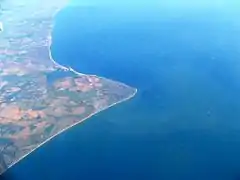 Aerial view | |
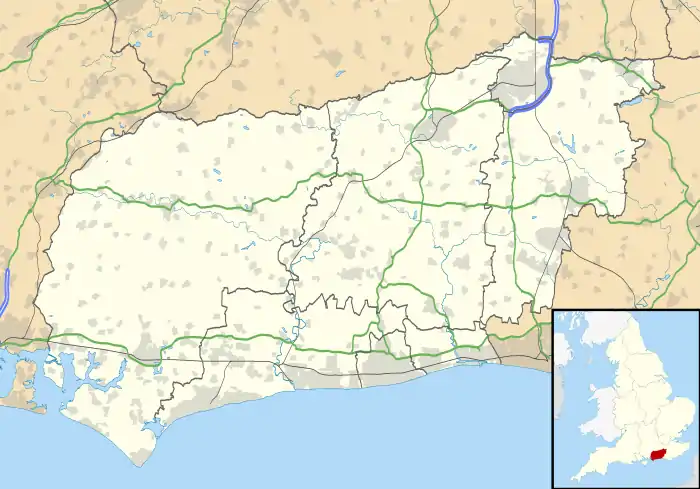 Selsey Location within West Sussex | |
| Area | 12.28 km2 (4.74 sq mi) [1] |
| Population | 10,737. 2011 Census[2] |
| • Density | 804/km2 (2,080/sq mi) |
| OS grid reference | SZ854935 |
| • London | 60 miles (97 km) NNE |
| Civil parish |
|
| District | |
| Shire county | |
| Region | |
| Country | England |
| Sovereign state | United Kingdom |
| Post town | CHICHESTER |
| Postcode district | PO20 |
| Dialling code | 01243 |
| Police | Sussex |
| Fire | West Sussex |
| Ambulance | South East Coast |
| UK Parliament | |
| Website | http://www.selseytowncouncil.gov.uk/ |
The B2145 is the only road in and out of the town crossing a bridge over the water inlet at Pagham Harbour at a point known as "the ferry". At one time Selsey was inaccessible at flood tide, and a boat was stationed at the ferry to take horses and passengers to and from Sidlesham.[5]
Place name
According to Bede the name Selsey is derived from the Saxon Seals-ey and can be interpreted as the Isle of Sea Calves (sea calves are better known as seals).[6]
Edward Heron-Allen identified at least twenty different spellings of the place that we now know today as Selsey.[7]
A selection of versions as identified by Heron-Allen are:
- Seoles – Old English
- Seleisi – Domesday Book 1086
- Celesye – Assize Roll 1279
History
The earliest evidence of human habitation in the Selsey area goes back to the stone age.[8] Various stone implements have been found which date to the Palaeolithic period.[9] People have been living in the area ever since.[10][11]

It is believed that, in the Iron Age, the Atrebates (one of the Belgae tribes) built a city at Selsey, similar in status to the pre-Roman urban centre ( oppidum) at Hengistbury Head near Christchurch.[11][13][14][15] So far there is no archaeological evidence to confirm this, although some have speculated that the old city that Camden refers to is, indeed the old Belgae settlement and was located at the Mixon rocks, now south of Selsey Bill.[16][17][18]
There have been various finds of silver and gold coins in the Selsey area.[19] Gold coins from the Atrebates rulers named Commius, Tincommius, Verica, Eppillus, and Cunobelin were found on the beach in 1877, it is thought that these coins would have been minted locally.[20][21] The ancient British coins would have been superseded by Roman coins and there have been finds of them too.[20][21] In addition, some Anglo-Saxon gold fragments were found on the beach between Selsey and Bognor, these were dated as late 6th/ 8th century and what made them particularly interesting is that they had a runic inscription on them, the fragments were handed over to the British Museum.[12][22]
Selsey was the capital of the Kingdom of Sussex, possibly founded by Ælle. Wilfrid arrived circa 680 and converted the kingdom to Christianity, as recorded by the Venerable Bede.[23] Selsey Abbey stood at Selsey (probably where Church Norton is today),[24] and was the cathedra for the Sussex Diocese until the Council of London ordered the removal of the See to Chichester in 1075, during the reign of William the Conqueror.[25]

In the Domesday Book Selesie is mentioned under the hundred of Somerley:[26]
"The Bishop(of Chichester) holds Selesie in domain.[27] In the time of King Edward it was rated at ten hides, and so it continues. The arable is seven plough lands.[27] There are two ploughs in the demesne, and fourteen villains with eleven bondsmen have five ploughs.".[27][28][29]
The manor of Selsey remained in the Bishop of Chichesters hands until 1561, when it was taken over by the crown.[28]
In July 1588 the Spanish Armada arrived off the Isle of Wight with the intention of attacking Portsmouth.[30] The wind changed direction to the south-west. Men from the Manhood Peninsula serving under Francis Drake conceived a plan to lure the Spanish fleet onto the Owers rocks (off Selsey).[18][30] However the Spanish Admiral, recognising the danger, decided to head for Calais.[30]
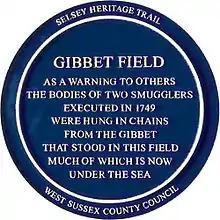
In 1647, a fatality was recorded following a cricket match at Selsey when a fielder called Henry Brand was hit on the head by the batsman Thomas Latter, who was trying to hit the ball a second time. The incident repeated one at Horsted Keynes in 1624.[31]
Over the centuries that Selsey has derived an income from the sea, one of the enterprises was smuggling.[32] In the eighteenth century Selsey Bill was very much more isolated than it is today, and the sand spit extended farther out to sea. There was only the causeway connected to the mainland and that was covered at high tide.[5] The approach of the local riding officer would have been conspicuous in the extreme.[33] The Rectors of Selsey reputedly claimed a tithe on all kegs landed there, and stories also tell of a passageway leading from the Old Rectory (at Church Norton) to the remains of a Mound, thought to have been built by the Normans.[34][35] The course of the tunnel was marked by a depression on the surface of the ground as late as 1911.[36][37]
In the 1720s one Selsey man ran a regular ferry service to France, traveling back and forth every five weeks, and other prominent Selsey figures made considerable fortunes just from part-time work in the free-trade.[33]
Landings were not confined to Selsey itself: in a single run in 1743 2,000 lbs of tea were brought inland at West Wittering some six miles (10 km) away.[33]

In 1749 fourteen smugglers, members of the notorious Hawkhurst Gang, were accused of the murder of Mr. William Galley, a custom-house officer, and Daniel Chater, a shoemaker.[38] Seven were tried and condemned to death at Chichester assizes; one died in gaol before sentence could be carried out and the other six were hanged at the Broyle north of Chichester.[39] Subsequently, the bodies of two of the smugglers, John Cobby and John Hammond, were hung in gibbets at Selsey Bill so that they could be seen at great distance from east and west.[40][41]
At the beginning of the 19th century, Selsey opened its first school. In 1818 premises were granted to the Rector and churchwardens of Selsey which were "on trust to permit the premises to be used for a schoolhouse or free school, for the gratuitous education of such poor children belonging to the Parish of Selsey as the said trustees or successors may think proper."[42] The school was eventually taken over by the local authority in 1937.[43]
Selsey was connected to Chichester from 1897 to 1935 by a rail link initially called the Hundred of Manhood and Selsey Tramway and later the West Sussex Railway. The light railway rolling stock was all second hand and not very reliable and the journey times lengthy. Various nicknames such as the "Selsey Snail" were attributed to the tram and comic postcards were issued reflecting its poor service.[44]
Landmarks
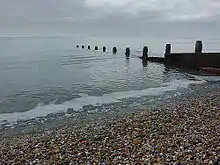

The parish has a couple of Sites of Special Scientific Interest. Bracklesham Bay runs along the coastline of the parish.[45] Pagham Harbour falls partly within the parish.[46] The harbour and surrounding land is of national importance for both flora and fauna. The shingle spit is also of geological interest.
Medmerry Mill is a grade II listed tower windmill restored in the 1960s and currently in use as a gift shop.[47]
Sport and leisure
Selsey has a Non-League football club Selsey F.C. who play at the High Street Ground.

Selsey Cricket Club
Selsey Cricket Club was founded in 1834 and is one of England's oldest cricket clubs.[48]
A former President was Hubert Doggart, OBE, MA. He was the son of the sportsman Graham Doggart who rose to chair the Football Association. Doggart represented England in two Test matches in 1950. He was President of the M.C.C. (1981–1982), the Cricket Council (1981–1982) and the Cricket Society (1983–1998), and he chaired the Friends of Arundel Castle Cricket Club (1993–2003). In the 1970s he played occasionally for Selsey C.C.
Sir Patrick Moore, CBE was a former club secretary, an active playing member, and an Honorary Life Vice President.[49][50] Selsey Cricket Club in Paddock Lane, is the home to the Sir Patrick Moore 3D Exhibition which recreates Moore's study at his home "Farthings" with original items on show.
Selsey are a Clubmark Club[49] running two men's League sides, one Ladies League side, several Junior sides and Sunday and Midweek Friendly sides.
Selsey Arts
The wide landscapes, exposed coastal location and diverse birdlife lure artists to Selsey, many of whom belong to Arts Dream Selsey Artists. The society holds regular exhibitions and events.[51] The list of artists, who have featured Selsey in their work, include Whistler and Turner.[52]
Education
Selsey has a secondary school called the Selsey Academy (formerly known as Manhood Community College up till September 2011) and two primary schools, Seal Primary School (now known as Seal Academy) and Medmerry Primary School.[53] Before and after the Second World War there were several private preparatory schools in Selsey including Broombank School housed in the former residence of the music hall entertainer Bransby Williams next to the Selsey Hotel.[54][55] The owner/headmaster from the early 1950s until the school's closure in 1969 was William Percy Higgs (died Bristol 1986), a former Cambridge University organ scholar and music master at Eton.[54] Higgs made Broombank a music and arts school attracting the children of well known actors, artists and musicians as well as temporary pupils from France, whose numbers occasionally matched those of the British children.[54]
RNLI Selsey Lifeboat
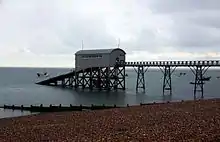
Selsey had an RNLI lifeboat station and shop on Kingsway, east of Selsey Bill. The station was established in 1861. In 2014 Selsey had a Tyne-class lifeboat and a D Class Inshore Lifeboat which had its own boat house just off the beach. In 2011 Selsey Lifeboat Station celebrated 150 years during which period lifeboat crew have received 10 awards for gallantry.[56]
A new boathouse, to replace the old off shore boathouse, has been constructed on shore. The final launch from the old boathouse was made on 1 April 2017. The new boathouse accommodates both the inshore lifeboat and the new Shannon-class lifeboat, which has been allocated to Selsey, to replace the Tyne class. The RNLI shop has also been transferred to the new building.[57]
Notable residents

Colin Pullinger (1814–94): A Victorian business man who was an undertaker, wooden pump maker, repairer of umbrellas, letter writer and clerk to the Selsey Sparrow Club. He was famed for making more than two million humane and perpetual mousetraps, which were exhibited at international exhibitions in London and Philadelphia. A blue plaque has been placed at the site of his Inventive Factory, which is today occupied by the offices of Selsey Town Council in the High Street.[59][60]
Edward Heron-Allen (1861–1943): Selsey's most distinguished resident in the early 20th century, Mr Heron-Allen made an enormous contribution to village life and today is still well known as the author of the classic work on local history for the area.[59][61]
Eric Coates (1886–1957) the English Composer lived and worked in Selsey. He was inspired to write By the Sleepy Lagoon after overlooking the sea towards Bognor Regis.[62] His musical composition can be heard as the theme tune to Desert Island Discs on BBC Radio 4.[58]
Air Commodore Edward 'Teddy' Mortlock Donaldson CB, CBE, DSO, AFC and Bar, LoM (USA) (1912–1992) who set a new world air speed record of 616 mph in September 1946, also breaking the 1,000 kilometres per hour (620 mph) barrier for the first time in the Star Meteor IV. Donaldson lived at Iron Latch Cottage and there is a blue plaque on the beach at the bottom of Park Lane to mark the event. Donaldson has a second plaque at No. 86, Grafton Road.[59]
Sir Patrick Moore (1923–2012) – astronomer, writer, researcher, radio commentator and television presenter, lived in Selsey from 1968 until his death.[50][63]
David Hewlett, (1968– ) British-born Canadian actor, writer, director and voice actor best known for his role as Dr. Rodney McKay on Stargate SG-1, Stargate Atlantis and Stargate Universe resided here for some time before he and his family later emigrated to Canada.[64]
Cultural references
Selsey Bill is referenced in the song "Saturday's Kids" by The Jam (from the 1979 album Setting Sons), along with Bracklesham Bay, as a place where these working-class children take holiday with their families; "Save up their money for a holiday/To Selsey Bill, or Bracklesham Bay."[65]
Selsey is also mentioned in Ben Jonson's play 'Volpone' in Act 2 Scene 1 in reference to 'Selsey cockles'.[66]
In the opening scene of the Lerner and Loewe musical My Fair Lady, Professor Higgins correctly identifies one of the characters as coming from Selsey.[67]
Selsey is further referenced in the Madness song "Driving in My Car": "I drive up to Muswell Hill, I've even been to Selsey Bill".[68]
Climate
Selsey's climate is classified as warm and temperate.[69] Although Selsey is in one of the sunnier areas of the UK,[70] there is rainfall throughout the year and even the driest month still has rain.[71] Probably the most problematic climatic hazard is wind.[72] The town is situated in an area where tornadoes and waterspouts are common.[73] A tornado in 1986 damaged 200 houses and cut a swathe 70 metres wide.[74] Another tornado in 1998 left an estimated £10m of destruction and damaged, the late, Patrick Moore's observatory.[74]
Nature
In 2015, around 50 Smooth-hound sharks were observed near the beach at Selsey.[75]
See also
Notes
- "2001 Census: West Sussex – Population by Parish" (PDF). West Sussex County Council. Archived from the original (PDF) on 8 June 2011. Retrieved 10 May 2009.
- UK Census (2011). "Local Area Report – Selsey Parish (E04009925)". Nomis. Office for National Statistics. Retrieved 15 April 2019.
- Parish. A Dictionary of the Sussex Dialect. pp. 96–97
- SCOPAC. Sedimentary Study from East Head to Pagham. Section 1.1. – The Standing Conference on Problems Associated with the Coastline (SCOPAC) was established in 1986 and consists of local authorities, the Environment agency and others. Archaeological evidence demonstrates that the coastline was some 2 to 3 km seawards of where it is now at about 5,000 years. Retrieved 5 February 2014
- Horsfield. History and Antiquities Vol II p.35.A man and horse paid twopence; a foot passenger one halfpenny. The farmers and renters paid annually a certain portion of corn..
- Bede. p.227
- Heron-Allen.Selsey Historic. pp.6 – 7
- Heron-Allen p.72.
- Heron-Allen. Plate XI
- Heron-Allen p.73
- Mee. pp.5 – 6. The early beginnings of Selsey.
- British Museum catalogue and description.
- Roman Sussex-Chichester and the Chilgrove Valley. Alec Down.p.52.The main oppidum of this shrunken kingdom was probably at Selsey
- History files. The Tribe of the Atrebates.
- English Heritage. National Monuments Record.
- Cambden. Britannia. p.228. At low water there are obscure Remains of that ancient little City where those Bishops resided
- Richardson. The Owers, p.76. If, as seems almost certain, The Mixon is the site of 'the old city' perhaps Cymenes ora itself...
- Admiralty Chart 2045 – This chart provides details of the coastal waters around Selsey Bill
- Mee. A History of Selsey, Chapter 2 – The author lists various finds and provides illustrations of the coins found
- Heron-Allen. Selsey Historic and Prehistoric . Chapter XXI — Description and pictures of coins found.
- British Museum Catalogue of pre-Roman coins at Selsey
- Hines. p.448 Two bits of gold found on the beach between Selsey and Bognor..
- Bede, Ecclesiastical History of the English People. ch.13
- L.F. Salzman, ed. (1953). "Selsey". A History of the County of Sussex: Volume 4: The Rape of Chichester. Institute of Historical Research. Archived from the original on 22 October 2012. Retrieved 19 October 2009.
- Horsfield. History and Antiquities Vol II. p.20. ... all cathedral churches should be removed from villages to cities.
- Powell-Smith, Anna. "Open Domesday: Hundred: Somerley". Anna Powell-Smith. Archived from the original on 5 January 2017. Retrieved 5 October 2016.
- Heron-Allen. Selsey Bill Historic and Prehistoric. p.132. That is to say that the Bishop of selsey(or Chichester) holds Selsey in his own hands, or as his own domain. He holds some of his lands in "demesne" for his own use, and lets out parts of it to tenants..
- Horsfied. History and Antiquities Vol II P.35
- Horspool. Alfred. p.102. A hide is a bit like a form of tax, it is the amount of men required to maintain and defend an area for the King. The Burghal Hideage defines the measurement as one hide would be equivalent to one man. The hidage explains for the maintenance and defence of an acres breadth of wall sixteen hides are required
- Mee. pp. 11 – 12. Description of what preparations Selsey made to support the action against the Armada
- McCann, p. xxxix.
- Mee. Ch.7 the author explains the various ways the sea has been important to Selsey. Including wrecks, wrecking and smuggling
- Smugglers Britain. Description of Selsey Bill and smuggling activities
- SAC. Volume 119. p.221 – talking about the Mound.. the earthworks were probably constructed in the Norman period and probably soon after 1066..
- Mee.p38. There is even a tradition in Selsey that some of the Rectors used to take a 'tythe of kegs'..
- Heron-Allen p.195. The author speculates that the gullys were built as part of the Armada defences.
- SAC Vol 119. pp. 218–219. Plan of the mound
- Smugglers and Smuggling. The book provides a narrative on the offence, capture, trial and execution of the smugglers involved.
- Platt. Smuggling in the British Isles: A History. pp.152–153
- Smugglers and Smuggling. p.124.
- Heron-Allen. Historic and Prehistoric. p.309. and copy of tithe map. The Author says that it is not clear where the gibbets would have stood, but in an old tithe map, there was a Gibbet Field and he feels that this would have been the most likely place. The field was immediately adjacent to Selsey Bill.
- Mee. p.75
- Mee. p.80
- Mee. pp.84–96. Information on the railway.
- "SSSI Citation – Bracklesham Bay" (PDF). Natural England. Archived from the original (PDF) on 25 May 2011. Retrieved 4 April 2009. Cite journal requires
|journal=(help) - "SSSI Citation – Pagham Harbour" (PDF). Natural England. Archived from the original (PDF) on 25 May 2011. Retrieved 4 April 2009. Cite journal requires
|journal=(help) - Historic England. "MEDMERRY WINDMILL (1026236)". National Heritage List for England. Retrieved 14 January 2018.
- Timothy J McCann (2004) Sussex Cricket in the Eighteenth Century, Sussex Record Society
- "Selsey Cricket Club Website". Archived from the original on 21 December 2016. Retrieved 21 December 2016.
- "Astronomer and broadcaster Sir Patrick Moore dies, aged 89". BBC. Archived from the original on 9 December 2012. Retrieved 9 December 2012.
- "Arts Dream Selsey Selsey Artists". Arts Dream Selsey. Archived from the original on 28 November 2020. Retrieved 21 November 2020.
- Bay with headland Selsey Bill by J.M. Turner Archived 28 May 2014 at the Wayback Machine. Tate website, Retrieved 18 May 2012.
- "Schools in Selsey". DofE. 2014. Archived from the original on 1 December 2014. Retrieved 1 December 2014.
- Mee. Chapter Nine. Education in Selsey.
- Kellys Directory (1938) pp.515 – 516. Entry for Broombank School: Broombank Boarding; School(Misses Morgan, principals), Manor road.. Entry for the Selsey Hotel: Selsey Hotel (Selsey Hotel Ltd.), Manor Rd.
- Selsey Lifeboat Archived 17 December 2005 at the Wayback Machine, RNLI Selsey Lifeboat, accessed 30 June 2012
- Last Launch Archived 27 April 2017 at the Wayback Machine, from the old boathouse, accessed 21 April 2017
- Eric Coates Remembered. Blue Plaque Citation by local council.
- Blue Plaque press release. Citation by county council of blue plaques awarded to Selsey and reasons.
- "The Novium – Pullinger Perpetual Mousetrap". thenovium.org. Archived from the original on 30 March 2014.
- Selsey Bill: Historic and Prehistoric, published in 1911
- "Eric Coates in Sussex", transcript Archived 13 August 2017 at the Wayback Machine of The Enchanted Garden, a BBC local radio programme, devised, scripted and produced by Ian Lace. Available on MusicWeb, Retrieved 14 November 2010.
- Moore. The Autobiography p.62 -We arrived in Selsey on 29 June 1968 ..
- "Famous Selsey" (PDF). Visit Selsey 2017. Selsey Life. 6 July 1998. Archived (PDF) from the original on 23 October 2017. Retrieved 23 October 2017.
- "Saturday's Kids (Lyrics)". Archived from the original on 27 February 2013. Retrieved 27 February 2013.
- Ben Johson. Volpone. Act 1. Scene 2. SIR POLITIQUE WOULD_BEE: "In oranges, musk-melons, and such like: sometimes in Colchester-oysters, and your Selsey-cockles.'
- Lerner and Lowe. My Fair Lady. Act 1 Scene 1. pp. 18 – 19. ..THE SELSEY MAN: "He ain't a tec. He's a gentleman, look at his shoes." HIGGINS: (Turning on him genially) "And how are your people down at Selsey?" THE SELSEY MAN: (Suspiciously) "Who told you my people come from Selsey?..."
- "Driving in my Car (lyrics)". Archived from the original on 27 February 2013. Retrieved 27 February 2013.
- World Map of the Köppen-Geiger climate classification updated. Retrieved 15 January 2018
- Average Maps Archived 16 January 2018 at the Wayback Machine Retrieved 15 January 2018
- Selsey Climate Archived 16 January 2018 at the Wayback Machine Retrieved: 15 January 2018.
- Gardiner and Matthews. The Changing Geography of the UK p. 362
- Doe. Extreme Weather. pp.73–74
- Town picks up the pieces after tornado Archived 31 March 2009 at the Wayback Machine BBC News 9 January 1998 retrieved 19 September 2010
- Up to 50 sharks filmed in West Sussex Archived 18 November 2016 at the Wayback Machine BBC
Sources
- Aldsworth, F.G.; Garnett, E.D. (1981). "Excavations at the Mound, Church Norton, Selsey. SAC Volume 119". Lewes: Sussex Archaeological Society. Cite journal requires
|journal=(help) - Bede, Venerablis; translated by Leo Sherley-Price (1988). A History of the English Church and People. Penguin Classics. ISBN 0-14-044042-9.
- Cambden, William (1701). Britannia Vol 1. London: Joseph Wild.
- Carter, Dave; Bray, Malcom (2003). "Sediment Transport Study East Head to Pagham Harbour". SCOPAC. Archived from the original on 24 February 2013. Retrieved 23 November 2009.
- Chart 2045. Outer Approaches to The Solent (Map). United Kingdom Hydrographic Office. 2005.
- Doe, Robert K. (2016). Extreme Weather: Forty Years of the Tornado and Storm Research Organisation (TORRO). Chichester: Wiley. ISBN 978-1-118-95109-5.
- Down, Alec (1978). Peter Drewett (ed.). Archaeology in Sussex to A.D.1500 (Research reports / Council for British Archaeology):Roman Sussex-Chichester and the Chilgrove Valley. London: Council for British Archaeology. ISBN 0-900312-67-X.
- Gardiner, Vince; Matthews, Hugh (2000). The Changing Geography of the UK (3 ed.). London: Routledge. ISBN 0-415-17900-9.
- Gentleman, A. (1749). Smuggling and Smugglers in Sussex. Brighton: W.J.Smith. - The author was simply described as A Gentleman of Chichester. Not clear why his identity was hidden!
- Heron-Allen, Edward (1911). Selsey Historic and Prehistoric. Duckworth.
- Hines, John (1990). BAMMESBERGER WOLLMANN (ed.). The Runic Inscriptions of Early Anglo-Saxon England. C.Winter. ISBN 3-533-04271-5.
- Horsfield, Thomas Walker (1835). The History, Antiquities and Topography of the County of Sussex Vol II Facsimile Edition 2009. Bakewell, Derbyshire: Country Books. ISBN 978-1-906789-16-9.
- Horspool, David (2007). Why Alfred Burnt the Cakes. London: Profile Books. ISBN 978-1-86197-779-3.
- Jonson, Ben (1929). Rea, John D (ed.). Volpone, or the Fox. Oxford: OUP. Retrieved 5 February 2014.
- "BLUE PLAQUES TRACE SELSEY HERITAGE Press Release Number:290". West Sussex County Council. 25 June 2002. Archived from the original on 27 February 2013. Retrieved 23 November 2009.
- "COMPOSER ERIC COATES REMEMBERED Press Release Number:347". West Sussex County Council. 6 July 1998. Archived from the original on 27 February 2013. Retrieved 23 November 2009.
- "Details of gold fragments found at Selsey". British Museum. Retrieved 23 November 2009.
- "British Museum database of coins found at Selsey". British Museum. Retrieved 5 October 2016.
- "Tribe of the Atrebates". History Files. Retrieved 23 November 2009.
- "Suggested late IA oppidum at Selsey". English Heritage. Archived from the original on 25 March 2012. Retrieved 3 March 2010.
- "Selsey Bill". Smugglers Britain. Retrieved 24 November 2009.
- "2001 Census: West Sussex – Population by Parish" (PDF). West Sussex County Council. Archived from the original (PDF) on 8 June 2011. Retrieved 25 October 2009.
- Lerner, Alan Jay; Loewe, Frederick (1958). My Fair Lady, a Musical Play in Two Acts, Based on Pymalion by Bernard Shaw. New York: The American Library.
- McCann, Timothy J. (2004). Sussex Cricket in the Eighteenth Century. Lewes: Sussex Record Society. ISBN 0-85445-055-6.
- Mee, Frances (1988). A History of Selsey. Chichester, Sussex: Philimore. ISBN 0-85033-672-4.
- Moore, Patrick (2003). The Autobiography. Stroud, Gloucestershire: Sutton. ISBN 0-7509-4014-X.
- Parish, W.D (1875). A Dictionary of the Sussex Dialect. A Collection of Provincialisms in use in the County of Sussex. Lewes, Sussex: Farncombe & Co.
- Platt, Richard (2007). Smuggling in the British Isles: A History . Stroud, Gloucestershire: Tempus Books. ISBN 978-0-7524-4249-5.
- Post Office Directory — Sussex. London: Kelly's Directories. 1938.
- Richardson, W.A.R. (2000–2001). The Owers. The English Placename Society Journal 33.
- Salzman, Louis Francis (1973). A Victorian History of the County of Sussex: Volumes 4 (facsimile ed.). London: Victoria County History. ISBN 0-7129-0588-X.
- "SSSI Citation — Bracklesham Bay" (PDF). Natural England. Archived from the original (PDF) on 25 May 2011. Retrieved 4 April 2009. Cite journal requires
|journal=(help) - "SSSI Citation — Pagham Harbour" (PDF). Natural England. Archived from the original (PDF) on 25 May 2011. Retrieved 4 April 2009. Cite journal requires
|journal=(help)
External links
| Wikimedia Commons has media related to Selsey. |
| Wikivoyage has a travel guide for Selsey. |